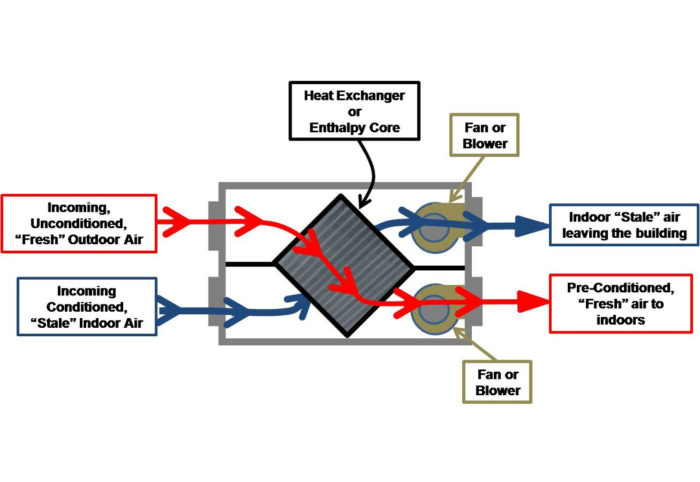Checking out the Perks of Heat Recovery Ventilation for Energy Efficiency in Homes
Heat Recovery Ventilation (HRV) systems offer home owners a functional method to boosting power performance. By recovering heat from outbound air, these systems can significantly reduce cooling and heating costs. Additionally, they provide a constant supply of fresh air, enhancing interior air high quality and convenience levels. As property owners take into consideration lasting alternatives, understanding the nuances of HRV systems becomes progressively important. What factors should one examine prior to making such an investment?
Understanding Heat Recovery Ventilation Solutions

How HRV Improves Indoor Air High Quality

Power Financial Savings: The Economic Benefits of HRV
Optimizing power performance, heat recovery ventilation (HRV) systems provide significant monetary benefits for home owners. By recovering and recycling warm from exhaust air, HRVs significantly reduce home heating and cooling prices. This modern technology can bring about power cost savings of approximately 30%, depending on climate and usage patterns. Property owners commonly notice lowered energy expenses soon after installment, making HRVs a financially wise financial investment with time. In addition, lots of areas provide rewards or refunds for energy-efficient upgrades, further improving the financial appeal. As energy rates remain to climb, the cost-effectiveness of HRVs comes to be significantly clear. Overall, the incorporation of HRV systems not just promotes power performance but also adds to long-lasting monetary cost savings for households.
The Environmental Impact of Heat Recovery Ventilation
A considerable ecological advantage of heat recovery ventilation (HRV) systems lies in their capacity to lower total energy intake. By reclaiming heat from exhaust air and moving it to incoming fresh air, HRV systems minimize the need for energy-intensive home heating and cooling down techniques. This decrease in energy need adds to decrease greenhouse gas exhausts, as less fossil gas is required view publisher site to keep comfy indoor temperature levels. Furthermore, HRV systems enhance interior air top quality by effectively exchanging stagnant air with fresh outdoor air, lowering dependence on mechanical cooling systems that can hurt the atmosphere. Generally, the application of HRV systems sustains lasting living practices and aligns with worldwide initiatives to combat climate adjustment by promoting energy efficiency in household setups.
Selecting the Right HRV System for Your Home
Just how can property owners ensure they pick the ideal heat recovery ventilation (HRV) system for their demands? They ought to evaluate their home's size and format, as these factors affect air flow requirements. Next off, examining the system's performance rankings is crucial, as higher rankings suggest much better efficiency and power financial savings. House owners should additionally consider setup and upkeep prices, contrasting different brand names and designs for worth. In addition, it is very important to evaluate sound degrees, as some systems run more quietly than others. Consulting with a/c experts can give customized referrals based upon details home conditions. Checking out individual reviews and service warranties can aid in making an informed choice, making certain that the chosen HRV system effectively improves interior air quality and energy efficiency.
Often Asked Questions

Exactly how Typically Should I Tidy or Keep My HRV System?
The regularity of cleansing or preserving a heat recovery air flow (HRV) system typically relies on usage and environmental factors. Usually, it is suggested to carry out upkeep every six months to ensure peak efficiency and air quality.

Can HRV Systems Help In Reducing Humidity Degrees Inside?
HRV systems can efficiently lower interior humidity degrees by trading stagnant, moist air with fresh, drier air from outside. HRV Heat Recovery Ventilation. This procedure helps preserve a balanced interior setting, enhancing convenience and preventing moisture-related problems
What Is the Lifespan of a Regular HRV System?
The life expectancy of a regular heat recovery ventilation (HRV) system differs, generally lasting between 10 to 15 years. Regular maintenance can expand its effectiveness and functional life, guaranteeing peak efficiency throughout Look At This its use period.
Exist Any Type Of Sound Issues With HRV Equipments?
Sound interest in HRV systems can emerge, particularly from fan operation. Nevertheless, several modern devices are designed to reduce audio degrees, ensuring they run quietly while maintaining efficiency, which resolves possible disturbances in living environments.
Can I Mount an HRV System Myself, or Do I Required an Expert?
The specific contemplated whether to set up the heat recovery ventilation (HRV) system directly or hire a professional. Generally, while do it yourself installation is possible, proficiency guarantees proper capability and conformity with local building regulations, improving system performance.